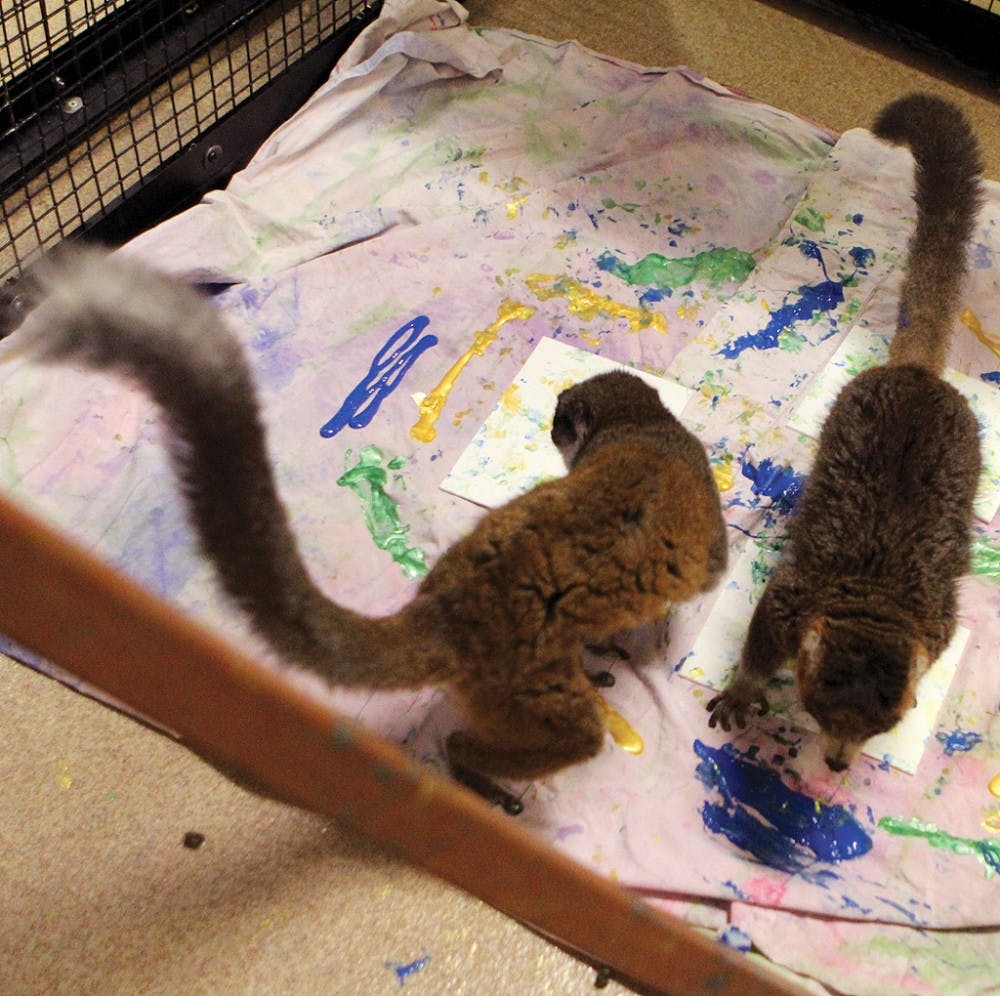Pedro and I only realized each others’ beings upon eye contact. What could have been the detached, rote inter-species interaction in which I normally engage, became an intense primate-to-primate recognition of “I am like you” as he challenged me to a staring contest.
His eyes, a pair of clementine pearls, sat totally transfixed in wonderment. I liked him. He made me feel interesting and important. As his gaze tried to unriddle me, mine worked to understand him. I broke eye contact to examine Pedro, noticing his ruffled auburn beard (which was handsomer than my scraggly black one). I was especially drawn to his feet, amazing enablers of agility—rubbery grippers and grabbers used to scale or pluck anything within arms’ reach. They were distinctly primatal in form.
Pedro is a mongoose lemur, a pair-bonded species hailing from northwest Madagascar. He lives at the Duke Lemur Center with his companion, Guadalupe—they have been roommates for more than a year, said Niki Barnett, the education program manager at the DLC. Today, the two were to be commissioned artists for me and my fellow journalists as a sort of pilot to the DLC’s new “Painting with Lemurs” tour, a program that allows visitors to experience lemurs as they bestow masterworks on the canvas.
My attention briefly left Pedro and shifted to Barnett as she explained the painting process. She emphasized the importance of enriching animals in captivity to ensure their healthy development. “The animals are in captivity, but they are not to be pets. They need stimulation,” Barnett said. “It gets them thinking. Any sort of enrichment provides them with stimulation and helps them engage in their natural behaviors. Plus they get extra treats!”
In this case, the treats were craisins, my childhood, by-the-fistful afternoon snack.
Pedro and Guadalupe were ready to paint and prepared themselves to impress us. They watched carefully as Fallon Owens, their primate technician, assembled their workspace. Owens lined the floor of the 13 foot by 13 foot cage with a dirty tarp and placed three small canvasses at its center in a sort of Stonehenge arrangement.
As Owens readied the materials, Barnett familiarized us with what it means to be a mongoose lemur.
“[Mongoose lemurs] are a docile, gentle and curious species,” she said as Owens dumped globules of paint on the periphery of the canvasses.
We chose gold, a martian-skin metallic green and Duke blue.
“Pedro—he’s more outgoing,” said Owens, reminding of me of my aforementioned stare-down with the male lemur. “He’s an in-your-face kind of guy. And they’re very compatible.”
Admittedly, I was only half-listening. As knowledgeable as the women were concerning the primates, I could not break my focus from the curious interactions between Homo sapiens sapiens and Eulemur mongoz. The seven of us (two lemurs, two specialists and three journalists) were engrossed in an interesting fluctuation between subject and object of what would unfold to be a beautiful piece of performance art. It became hard to discern who was captive and who was captor.
“They’re experienced artistes,” Barnett said, noting the fact that this was not the first time Pedro and Guadalupe had tried their hands (and feet) at painting.
Crouched on the ground, Owens invited the lemurs to the canvasses by scattering craisins over the work area. Some landed atop the blank canvasses, others found themselves comfortably bathing in (non-toxic!) blue or green or gold.
I was delighted when the performance began. Pedro and Guadalupe dismounted from their perch and descended to devour the constellation of dried fruit that awaited beneath them. As they foraged, they painted. I cannot help but believe that they, too, knew they were producing art.
The black undersides of their hands and feet transformed into color-coated painting tools. Their long, gray tails—something that we observing humans lost in millennia past—dragged through the paint. The tails were most amazing: anatomical paintbrushes with heightened mobility and dexterity. Soon, their teeny mouths became glazed with color as they covetously shoved the craisins in their faces. Like all great artists, an insatiable hunger drove them.
As Owens tossed more berries and the feast continued, Pedro and Guadalupe traversed the canvasses repeatedly, applying more and more paint with their extremities and underbellies. What formed beneath them was an interpretation of a Jackson Pollock.
Owens put away the bucket of snacks and retrieved the finished paintings from the cage floor. “I think they look great,” she said.
I stared at my painting in the same manner than I had stared into Pedro’s eyes upon our first impression. It looked something like a hurricane in a desert or perhaps more like the contents of the gutter at the swimming pool I work at in the summers. Regardless, it was art and it was beautiful. Pedro and Guadalupe could not give it a title, so I did.
Behold: “Sunflowers and a Field Mouse on a Rainy June Afternoon.”
Get The Chronicle straight to your inbox
Signup for our weekly newsletter. Cancel at any time.

